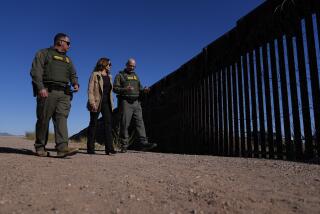New INS Chief Opposes Ditch Along Border
WASHINGTON — In his first public appearance since his Senate confirmation, Immigration and Naturalization Service Commissioner Gene McNary said Wednesday that he opposes a controversial proposal to dig a 4-mile ditch along the U.S.-Mexican border near San Diego.
“I don’t think the ditch is a very good idea,” McNary said at a press conference.
When asked if he favors any form of physical barrier along the Mexican border, McNary said he wants to look at that possibility. But, in another apparent reference to the ditch, he added: “Some of the suggestions made heretofore, I’m not locked into them.”
The new immigration commissioner said also that he plans to visit the Soviet Union to determine the extent of persecution of Jews in that country and plans to meet with advocacy groups who have been critical of the INS.
His comments on the border ditch appeared to doom the controversial proposal, which was supported by former INS Commissioner Alan C. Nelson but condemned by immigrant rights groups and the Mexican government.
The ultimate decision on the ditch rests with Atty. Gen. Dick Thornburgh, who is still considering it as an option, David Runkel, his spokesman, said. “He’s not made any final determination,” said Runkel, who set no timetable for a decision.
The proposed ditch would be 14 feet wide and 5 feet deep and would extend along a 4-mile stretch of the Otay Mesa, a broad expanse of flat arid land east of the port of entry at San Ysidro.
The concept, originally proposed as an environmental project to catch rainwater runoff, was taken over by the INS early this year because of its potential for curbing illegal immigration and drug trafficking.
U.S. authorities have said that hundreds of vehicles carrying illegal immigrants and drugs go across the border in that region each month. But the number has declined considerably since earlier this year, according to immigration officials in San Diego.
Detractors likened the ditch proposal to a U.S. version of the Berlin Wall, contending that the physical barrier would emphasize divisions between the United States and Mexico at a time when Mexico City and Washington are working toward improved relations.
Justice Department officials are reviewing concerns about the project, including Mexico’s opposition, Runkel said. “There are international-relations impacts, which the attorney general will take into consideration,” he said.
If the ditch is indeed dead, discussion appeared likely to center on what kind of alternate barrier would be built in the area, or whether improvements would be made to the porous fence and tattered metal cable that mark the border in the Otay Mesa area, where the ditch was to be built.
For some time, one INS official said, there had been a growing sentiment within the agency that the ditch would never be built. The official cited a range of reasons, including the clamor against the project, safety concerns and fears that it could be used as a trash dump.
An INS official said McNary’s statement means that the agency is unlikely to proceed with its plans for the $2-million excavation project. “The idea has just died a natural death,” the official said.
In San Diego, word of McNary’s opposition to the ditch was applauded.
“We had asked both sides to work together to seek a resolution to the problems,” said Paul Downey, spokesman for Mayor Maureen O’Connor. “This is a resolution which certainly is satisfactory to her, and I’m sure will be very satisfactory to the Mexican government.”
Bob Filner, a city councilman who has argued against the project, added: “I’m delighted that he has taken that position. I hope we’re going in the direction of doing something that’s acceptable to both governments.”
Roberto Martinez, a rights activist in San Diego who has expressed his opposition to the ditch, said he was gratified, albeit not surprised, by McNary’s comments.
“My feeling all along is that the INS wants to back out as gracefully as possible because of all the pressure,” Martinez said.
McNary, in his comments on Soviet Jews, said one of his initial priorities will be a visit to the Soviet Union to determine if Jews who want to immigrate to the West are still being persecuted.
He said he wants to study the reforms initiated by Soviet leader Mikhail S. Gorbachev and assess the level of intimidation experienced by Jews in the country.
Under previous U.S. policy, virtually any Soviet citizen who obtained permission to leave the country was granted refugee status and admitted to the United States.
In September, however, the Bush Administration adopted new rules that limit immigration to applicants who have parents, children, brothers, sisters or spouses living in the United States. Some exceptions are allowed for cases “of special concern to the United States.”
The new policy was adopted after U.S. officials realized that recent Soviet reforms had resulted in more applications by Soviet citizens to enter this country than immigration officials could handle.
“My concern is what’s happening to those Soviet Jews who want to come to this country,” McNary said, adding that he wants to determine if the Soviet government is persecuting or intimidating those seeking to move to the United States.
“That’s one of the things I’d like to go to Moscow to see. I think we need first-hand observations of the situation in Moscow.”
More to Read
Sign up for Essential California
The most important California stories and recommendations in your inbox every morning.
You may occasionally receive promotional content from the Los Angeles Times.










